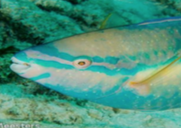Many environmental variables may influence fish assemblage structures in terms of abundance, biomass and mean size. The aim of this study is to provide a baseline survey on reef fish assemblages and shark presence covering the whole Saba bank (Dutch Caribbean). Hereby determining the influence of habitat, depth and fishing pressure on the structure of reef fish assemblages and shark presence. Baited Remote Underwater Video (BRUV) survey was used to describe reef fish assemblage structures on the Saba bank. Between 2012-2014, a total of 165 60 min BRUV deployments were conducted on locations varying in habitat complexity (0-4, Polunin and Roberts, 1993), depth (15-40m) and fisheries. The eleven most abundant fish species observed on the Saba bank represented eight families and accounted for nearly 50% of the total number of individual fish observed. Labridae was the most abundant fish family observed with a relative abundance of 22%. Most abundant fish species by number of individuals were Thalassoma bifasciatum (N=849 (9.8%)) Stegastus partitus (N=725 (8.4%)) and Acanthurus bahianus (N=430 (5.0%)).
Habitat complexity was positively correlated with species richness (Nsp), fish abundance (MaxN), and mean biomass, and negatively correlated with mean fish length. Strongly developed vertical relief habitats were found to support high numbers of fish species (N=19.1±0.6SE) of relatively low mean lengths (22.4cm±0.3SE), whereas less complex habitats were characterized by low numbers of species (N=8.3±0.8SE) with relatively high mean lengths (24.6cm ±0.81SE). Depth was negatively correlated with Nsp, MaxN and mean biomass and positively correlated with mean fish length. These relationships were all according to expectations based on earlier studies.
A minor part of the variability in the structure of reef fish assemblages was explained by differences in fisheries activity, indicating that no clear fisheries effect was observed in fish assemblages in this study. Furthermore, no significant differences in average size of target species were observed between areas with different fishing pressure. However, the general absence of piscivores such as large snappers and groupers was an indication of the indelible effects of past fisheries on the Saba bank.
A total of 85 shark observations were made with Ginglymostoma cirratum as most abundant species (N=41), followed by Carcharhinus perezii (N=36), Galeocerdo cuvier (N=5) and Carcharhinus limbatus (N=3). Relatively high shark abundances (0.20 sharks hour-1) were observed on the Saba bank compared with other Caribbean regions (The Bahamas: 0.14 sharks hour-1, Belize, 0.17 sharks hour-1). Shark abundance (CPUE) was positively correlated with habitat complexity, whereas depth exerted a negative influence on shark abundances. High shark numbers are a good sign for the health of the Saba Bank ecosystem, since sharks are apex predators, making them a prime indicator for ecosystem health.
Besides ‘traditional’ measures, ecomorphology was presented as an alternative measure in explaining variation in reef fish assemblages. For ecomorphological analysis insight in trophic morphology was obtained by using a Fish Food Model (FFM). The FFM in this study quantitatively related properties of 14 marine food types to morphological characterics of 15 common fish species on the Saba bank and predicted the capacity of utilizing these food types for each species. Strong differences in morphology and little overlap was observed for all different fish species in the FFM-analysis, which was mainly explained by two sets of variables involving predatory and herbivorous lifestyle. By multiplying each species’ capacity of using food types with its abundance an ecomorphological profile of each fish assemblage was calculated. On a functional level reef fish assemblages showed less variability than on species composition level, this possibly is an indication for high levels of robustness in niche differentiation in reef fish communities on the Saba bank.



